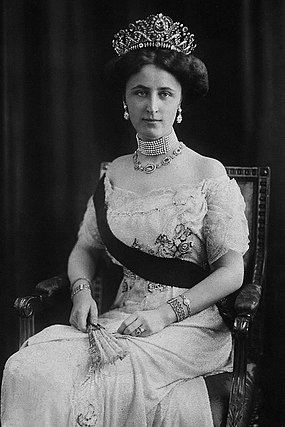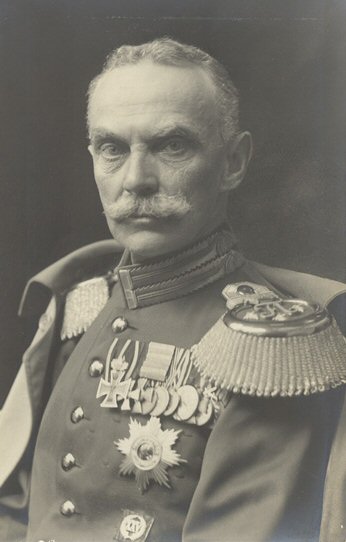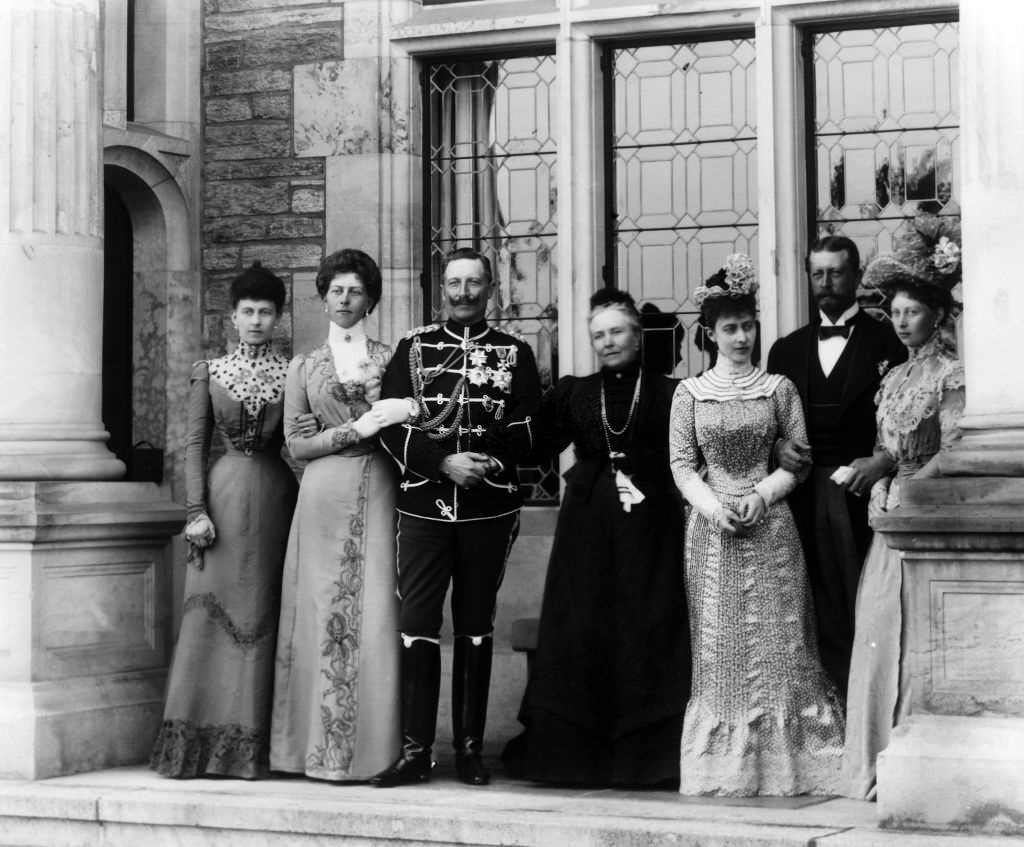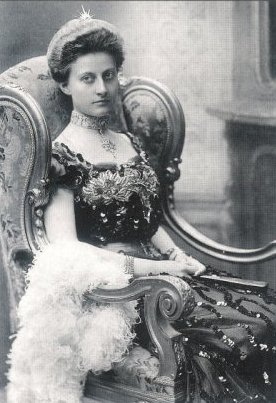by Scott Mehl © Unofficial Royalty 2018
Duchy of Saxe-Meiningen: On March 26, 1675, Ernst I, Duke of Saxe-Gotha-Altenburg died. Initially, his seven sons collectively governed the Duchy of Saxe-Gotha-Altenburg, as set out in their father’s will. On February 24, 1680, the seven brothers concluded a treaty of separation, with each brother getting a portion of the Duchy of Saxe-Gotha Altenburg and becoming a Duke. One of the seven new duchies was the Duchy of Saxe-Meinigen and Bernhard, one of the seven sons of Ernst I, Duke of Saxe-Gotha-Altenburg became the first Duke of Saxe-Meinigen.
On November 9, 1918, Wilhelm II abdicated as German Emperor and King of Prussia in the wake of the November Revolution. Bernhard III, the last Duke of Saxe-Meiningen abdicated the next day due to pressure from the Meininger Workers and Soldiers Council. His half-brother Ernst waived his succession rights on November 12, 1918, officially ending the monarchy of the Duchy of Saxe-Meiningen. Today the territory that encompassed the Duchy of Saxe-Meiningen is in the German state of Thuringia.
********************
Bernhard I, Duke of Saxe-Meiningen; Credit – Wikipedia
Bernhard I was the first Duke of Saxe-Meiningen, reigning from 1675 until his death in 1706. He was born in Gotha, Duchy of Saxe-Gotha, now in Thuringia, Germany, on September 10, 1649, the sixth son of Ernst I, Duke of Saxe-Coburg and Elisabeth Sophie of Saxe-Altenburg. Bernhard had 17 siblings:
- Johann Ernst (born and died 1638) – died in infancy
- Elisabeth Dorothea (1640-1709) – married Ludwig VI, Landgrave of Hesse-Darmstadt, had issue
- Johann Ernst (1641-1657) – died in childhood from smallpox
- Christian (1642) – died at birth
- Sophie (1643-1657) – died in childhood from smallpox
- Johanna (1645-1657) – died in childhood from smallpox
- Friedrich I, Duke of Saxe-Gotha-Altenburg (1646-1691) – married (1) Magdalena Sibylle of Saxe-Weissenfels, had issue; (2) Christine of Baden-Durlach, no issue
- Albert, Duke of Saxe-Coburg (1648-1699) – married (1)Marie Elisabeth of Brunswick-Wolfenbüttel, had issue; (2) Susanne Elisabeth Kempinsky, no issue
- Heinrich, Duke of Saxe-Römhild (1650-1710) – married Marie Elisabeth of Hesse-Darmstadt, no issue
- Christian, Duke of Saxe-Eisenberg (1653-1701) – married (1) Christiane of Saxe-Merseburg, had issue; (2) Sophie Marie of Hesse-Darmstadt, no issue
- Dorothea Maria (1654-1682) – unmarried
- Ernst, Duke of Saxe-Hildburghausen (1655-1715) – married Sophie of Waldeck, had issue
Johann Philip (born and died 1657) – died in infancy - Johann Ernst IV, Duke of Saxe-Coburg-Saalfeld (1658-1729) – married (1) Sophie Hedwig of Saxe-Merseburg, had issue; (2) Charlotte Johanna of Waldeck-Wildungen, had issue
- Johanna Elisabeth (born and died 1660) – died in infancy
- Johann Philip (1661-1662) – died in infancy
- Sophie Elisabeth (born and died 1663) – died in infancy

Maria Hedwig of Hesse-Darmstadt; Credit – Wikipedia
On November 20, 1671, at Schloss Friedenstein in Gotha, Duchy of Saxe-Gotha, now in Thuringia, Germany, Bernhard married Marie Hedwig of Hesse-Darmstadt. She was the daughter of Georg II, Landgrave of Hesse-Darmstadt and Sophie Eleonore of Saxony. They had seven children:
- Ernst Ludwig I, Duke of Saxe-Meiningen (1672-1724) – married (1) Dorothea Maria of Saxe-Gotha-Altenburg, had issue; (2) Elisabeth Sophie of Brandenburg, no issue
- Bernhard (1673-1694) – unmarried
- Johann Ernst (1674-1675) – died in infancy
- Marie Elisabeth (born and died 1676) – died in infancy
- Johann Georg (1677-1678) – died in infancy
- Friedrich Wilhelm, Duke of Saxe-Meiningen (1679-1746) – unmarried
- Georg Ernst (1680-1699) – unmarried, died from smallpox
Several years after their marriage, Bernhard and Marie Hedwig took up residence in Ichtershausen, Duchy of Saxe-Meinigen, now in the German state of Thuringia, where Bernhard had a castle built. Schloss Marienburg was named in Marie Hedwig’s honor. Just three weeks after giving birth to their youngest child, and only nine weeks before their planned move to Meiningen, Marie Hedwig died in Ichtershausen on April 19, 1680.

Elisabeth Eleonore of Brunswick-Wolfenbüttel; Credit – Wikipedia
On January 25, 1681, Bernhard married for a second time in Schöningen, Duchy of Brunswick-Wolfenbüttel, now in the German state of Lower Saxony. His new bride was Elisabeth Eleonore of Brunswick-Wolfenbüttel, the daughter of Anton Ulrich, Duke of Brunswick-Wolfenbüttel and Juliane of Schleswig-Holstein-Sonderburg-Norburg. The couple had five children:
- Elisabeth Ernestine (1681-1766) – unmarried
- Eleonore Friederike (1683-1739) – unmarried
- Anton August (born and died1684) – died in infancy
- Wilhelmine Luise (1686-1753) – married Carl, Duke of Württemberg-Bernstadt, no issue
- Anton Ulrich, Duke of Saxe-Meiningen (1687-1763) – married Charlotte Amalie of Hesse-Philippsthal, had issue
When Bernhard’s father died in 1675, instead of passing everything to his eldest son, he instead chose to divide his territory amongst his living sons. Each received part of the duchy and was expected to rule jointly – but under the authority – of the eldest one. Bernhard received Meiningen and the surrounding area, including the former principality of Henneberg. By 1680, the brothers had formally divided their lands, each becoming the ruler of the newly established duchies. Bernhard became the first reigning Duke of Saxe-Meiningen.

Elisabethenburg Palace; Credit – Wikipedia
Having moved to Meiningen and taking up residence at the Meiningen Castle, Bernhard soon made plans to build a new official residence in the city. The Elisabethenburg Palace was built between 1682-1692 and was named for his second wife. In addition to the new palace, Bernhard also established a court orchestra in 1690, and the Schlosspark in 1692.

Castle Church at Elisabethenburg Palace; Credit – Wikipedia
Bernhard I, Duke of Saxe-Meiningen died in Meiningen, Duchy of Saxe-Meiningen, now in Thuringia, Germany, on April 27, 1706. He is buried in the Castle Church at Elisabethenburg Palace in Meiningen.
This article is the intellectual property of Unofficial Royalty and is NOT TO BE COPIED, EDITED, OR POSTED IN ANY FORM ON ANOTHER WEBSITE under any circumstances. It is permissible to use a link that directs to Unofficial Royalty.
Saxe-Meiningen Resources at Unofficial Royalty













